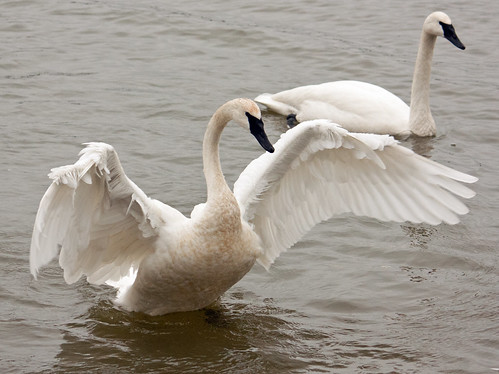The area around Thief River Falls, Minnesota, is known for its diverse and abundant wildlife. The city lies in close proximity to many stunning parks and wildlife refuges where you can spot anything from a prairie chicken to an elk or a bear. Here are a few places you can visit in the area to view beautiful natural habitats and the wide variety of animals that live there.
The Pine to Prairie Birding Trail

The well-known Pine to Prairie Birding Trail, which is a 200-mile trail featuring 51 viewing sites, winds through the Thief River Falls area. Along this trail, birdwatchers can view many of the 275 species of birds that inhabit the diverse ecosystems of northwest Minnesota. These include majestic trumpeter swans, various owl species, the iconic common loon, and majestic bald eagles.
If you’re new to the game of birding, the easiest way to access the Prairie Birding Trail is by visiting one of the nearby national wildlife refuges, such as the Agassiz National Wildlife Refuge. The best times to spot birds are at dusk and dawn, since this is when they’re feeding and most active. Those who are experienced birders and want to view rarer and unique species, such as the great gray owl or three-toed woodpecker, should head towards the north end of the trail.
Agassiz National Wildlife Refuge
The Agassiz National Wildlife Refuge, which is located a 26-minute drive out of Thief River Falls, was founded in 1937 to provide a breeding ground for migratory birds and other wildlife. Today, this is still the primary function of the 61,500-acre refuge. It boasts diverse landscapes and habitats, including one of America’s most endangered ecosystems, namely oak savanna. This ecosystem provides a habitat for various mammal, bird, and insect species, including black bears, red-headed woodpeckers, American kestrels, and eastern kingbirds.
The refuge also features sedge meadows, which are wetlands consisting of rushes, sedges, and water-loving grasses. Sedge meadows have become increasingly rare due to agricultural production and development. Since the reestablishment of this ecosystem in the refuge, many bird species have flocked to the area. These include the sharp-tailed sparrow, sedge wren, and Le Conte’s sparrow, which use these wetlands for foraging and nesting.
You’ll easily spot the red-necked grebe, which is a distinctive medium-sized waterbird that builds its nest within or close to emergent wetlands. These birds have a loud mating call and can be seen swimming in the wetlands of the refuge with their babies on top of their backs in the summer months. Other animals that you may see in the refuge include deer, wolves, and moose.
Glacial Ridge National Wildlife Refuge
About a 39-minute drive outside of Thief River Falls, you’ll find Glacial Ridge National Wildlife Refuge. This beautiful landscape is located where ancient glacial Lake Agassiz once lay between 9,000 to 12,000 years ago. On its eastern edge, the refuge is bordered by lakes and hardwood forests, while its western edge borders on the Red River Valley, which is tallgrass prairie land.
The refuge forms part of the Mississippi Headwaters/Northern Tallgrass Prairie ecosystem, which consists of a mix of small wetlands and surrounding upland prairies and woodland savannas. The area provides vital breeding habitat for many migratory birds, such as shorebirds, songbirds, and waterfowl. Another animal that uses the wetlands to breed is the northern leopard frog. The adults are semi-terrestrial and can be found in the tallgrass prairie or damp wooded areas in summer. In the winter, the frogs return to the wetlands where they hibernate until spring.
An animal you might easily spot in the prairies is the greater prairie chicken. This is a large land bird that was nearly extinct by the 1930s, as they didn’t adjust well to the roads, power lines, and agriculture of the modern world. The restoration of tallgrass prairies in the refuge has provided a much-needed home for these animals, and their numbers are steadily increasing. Get up at dawn if you want to see the mating dance of the males, which is quite the show.
Beltrami Island State Forest
Beltrami Island State Forest, which is located in Thief River Falls, also forms part of the area where glacial Lake Agassiz existed. When you visit the state forest, you can view the ancient shorelines of the lake, which are now low, sandy ridges covered in pine trees. The rest of the area consists of low flatlands and peat bogs, which are interspersed by “islands” of woody growth. A unique feature of the state forest is that it boasts seven scientific and natural areas, which are areas in Minnesota that feature natural plant communities and rare species.
A rich variety of animals and insects have made the state forest their home. Birders have spotted more than 250 birds in the area, including gray jays, white-winged and red crossbills, northern goshawks, great gray owls, and northern hawk owls. Other animals you might see in the area include gray wolves, red foxes, black bears, bobcats, white-tailed deer, beavers, and snowshoe hares.
There are also moose; however, their numbers are sadly declining in the state forest, and also in the larger area of Northeastern Minnesota. Scientists have been studying this phenomenon and are contributing their decline to various factors, such as warmer temperatures, parasites, and wolves.
These are just a few of the many spots in and around Thief River Falls that you can visit to view abundant and diverse wildlife. Now that spring is here, dust off your hiking boots and spend some time inspecting the beautiful landscapes of the region.
Contact Rydell Outlet
If you don’t live in the area but are planning a visit to get to know its fauna and flora up close and personal, feel free to contact Rydell Outlet. We will gladly help you find the perfect vehicle so that you can drive to all the beautiful natural sites in and around Thief River Falls.


